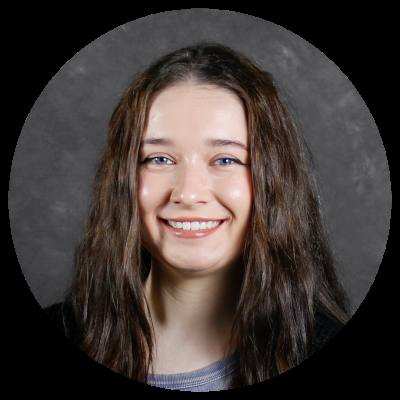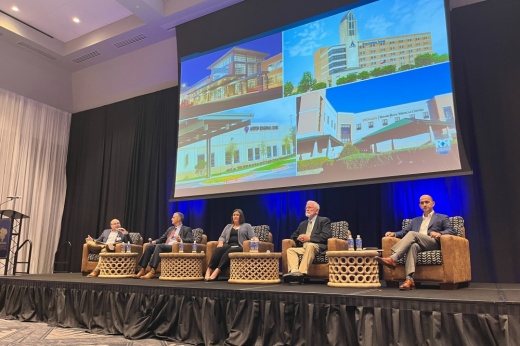The panel included Dr. Anas Daghestani, president and CEO of Austin Regional Clinic; Dr. Erin Koval, chief medical officer of Ascension Seton Williamson; Dr. Michael Craun, chief medical officer of St. David’s Round Rock Medical Center; and Dr. Ghassan Salman, regional chief medical officer of Baylor Scott & White. Dr. Matt Hoffman, assistant dean at the Texas A&M School of Nursing, moderated the panel.
Questions and responses have been edited for length and clarity.
Growth has created a greater need for health care services in the area. How are each of your organizations increasing the capacity to help fulfill and deliver that care need in the community?
Daghestani: One of the things we look at is trying our best to make sure that our staff and physicians live in that community and are part of that community, because they’ll have a better understanding of what services are needed. ... Access for health care has been a challenge for us, and even though it’s a healthy growing community, a lot of us are working really hard to maintain access, because we know without access you have delay in care and that will have a negative impact on annual totals that employers spend on health care.
Baylor Scott & White has expressed a strategic focus on customer centricity. Can you share exactly what that is and how it impacts health care?
Salman: Customer centricity means putting the patient at the center of our attention. We think of customer centricity not just as a strategy; it’s a way we live. ... Our goal is to study the patient’s journey and try to simplify these interactions or innovate in bringing new solutions. ... A few years ago, the organization committed to redesign how the patients interact with our clinics and hospitals. The system invested in resources, including a significant project—$2.5 million—with seven teams. Each team is looking at a separate step in the patient’s journey, which includes: how do patients find care? How do patients make appointments? How do patients check in? How do patients receive care, and within that, how do patients interact with their physicians and how do patients interact with clinic staff? How do patients get follow-up care? How do patients pay bills? How do we help patients get care at home? ... One of the [solutions] has been the MyBSWHealth app. ... That app helps patients interact with our health care system.
Ascension Seton Williamson is a Level II trauma provider. How does that designation benefit this area?
Koval: One of the things we recognize for the community is how important it is for you guys to stay close to home to receive your care. ... It’s probably not more important in any service line than trauma care. The single most important thing to your outcome when you’re involved in a major traumatic injury is access and time to your definitive place of care. ... We have to be prepared for any disaster that might come and affect our community. Being a Level II trauma center helps us create structure and preparedness around disaster preparedness planning.
We also have a Level II trauma center at St. David’s Round Rock. Given the population growth and increased need that we’re seeing in this community, can you share the importance of this facility and what it brings to trauma care?
Craun: The commitment to these hospitals is very strong. To be a Level II trauma center takes a lot of financial resilience, as well as physician buy-in and commitment. The trauma surgeon has to stay in the hospital and be immediately available for any severely injured patient. You have to have anesthesiologists in-house 24/7. You have to have an operating room standing open and ready to take a patient 24/7. Interventional radiology has to respond within 30 minutes of a surgery; orthopedics have to respond in 30 minutes if needed. ... It’s very important that your medical staff that supports these institutions is very dedicated. I have had the same trauma surgeons for the last 13 years. That’s unheard of in my profession that a group would stay and take care of the trauma [center].
Research automatization and even AI are starting to find their place within the health care industry, specifically medicine. Can you share your insights on where we are with those and where you think we’re headed?
Daghestani: In the last year or two, we’ve started adding more AI tools. ... One company we’re working with is called Notable, so if you’re doing the very exciting annual registration of your health care plan or you have to update the information of your plan, you take a picture of your insurance card and a bot will read that and put [your information] in the right place so when you arrive at the office you don’t have to go through the registration process. When we started, it was 30-40% accurate. We’re getting it to 70-80%. That enhanced access gives you the power to do your registration when you want to.
Last year, there were a lot of reports about the “triple-demic” with RSV, COVID and flu. I’d like to invite any of you to share your perspectives on the upcoming flu season and any other health care concerns.
Koval: We enter flu season when we enter the busiest season surgically [at the hospital] in our entire year. ... Hospital capacity tends to swell in the winter months, and it’s a great time to try and stay out of the hospital if you can. Go see your primary care provider and do what you can to prevent these illnesses. Vaccines are one amazing tool, but preventing health in general and being as healthy as you can at your baseline is going to keep you well when you do inevitably contract one of these illnesses. COVID taught me a lot. One of the things it taught me is really just back to the basics: it is really washing your hands, not touching your face, covering your sneezes and coughs and staying home when you’re sick.





